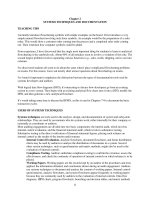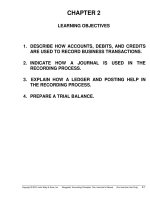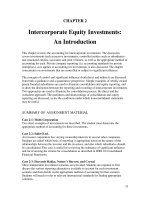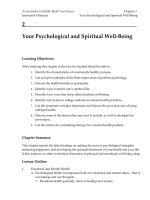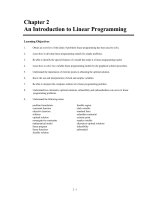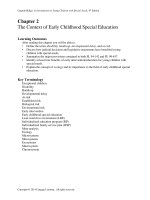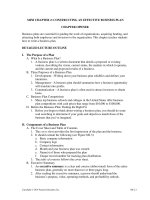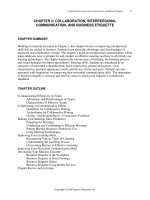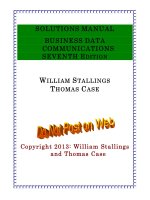Test bank and solution of how to program 7e (2)
Bạn đang xem bản rút gọn của tài liệu. Xem và tải ngay bản đầy đủ của tài liệu tại đây (1.03 MB, 22 trang )
2
What’s in a name?
That which we call a rose
By any other name would
smell as sweet.
—William Shakespeare
When faced with a decision, I
always ask, “What would be the
most fun?”
—Peggy Walker
“Take some more tea,” the
March Hare said to Alice, very
earnestly. “I’ve had nothing yet,”
Alice replied in an offended
tone: “so I can’t take more.” “You
mean you can’t take less,” said
the Hatter: “it’s very easy to take
more than nothing.”
—Lewis Carroll
High thoughts must have high
language.
—Aristophanes
Objectives
In this chapter, you’ll:
■
■
■
■
■
■
■
Write simple computer
programs in C.
Use simple input and output
statements.
Use the fundamental data
types.
Learn computer memory
concepts.
Use arithmetic operators.
Learn the precedence of
arithmetic operators.
Write simple decisionmaking statements.
Introduction to C
Programming—Solutions
Self-Review Exercises
2
Self-Review Exercises
2.1
2.2
Fill in the blanks in each of the following.
.
a) Every C program begins execution at the function
ANS: main.
and ends with
.
b) Every function’s body begins with
ANS: left brace, right brace.
.
c) Every statement ends with a(n)
ANS: semicolon.
standard library function displays information on the screen.
d) The
ANS: printf.
character, which causes the cursor
e) The escape sequence \n represents the
to position to the beginning of the next line on the screen.
ANS: newline.
Standard Library function is used to obtain data from the keyboard.
f) The
ANS: scanf.
is used in a scanf format control string to indicate
g) The conversion specifier
that an integer will be input and in a printf format control string to indicate that an
integer will be output.
ANS: %d.
h) Whenever a new value is placed in a memory location, that value overrides the previous
.
value in that location. This process is said to be
ANS: destructive.
i) When a value is read from a memory location, the value in that location is preserved;
.
this process is said to be
ANS: nondestructive.
statement is used to make decisions.
j) The
ANS: if.
State whether each of the following is true or false. If false, explain why.
a) Function printf always begins printing at the beginning of a new line.
ANS: False. Function printf always begins printing where the cursor is positioned,
and this may be anywhere on a line of the screen.
b) Comments cause the computer to print the text after the // on the screen when the program is executed.
ANS: False. Comments do not cause any action to be performed when the program is executed. They’re used to document programs and improve their readability.
c) The escape sequence \n when used in a printf format control string causes the cursor
to position to the beginning of the next line on the screen.
ANS: True.
d) All variables must be defined before they’re used.
ANS: True.
e) All variables must be given a type when they’re defined.
ANS: True.
f) C considers the variables number and NuMbEr to be identical.
ANS: False. C is case sensitive, so these variables are different.
g) Definitions can appear anywhere in the body of a function.
ANS: False. A variable’s definition must appear before its first use in the code. In Microsoft
Visual C++, variable definitions must appear immediately following the left brace
that begins the body of main. Later in the book we’ll discuss this in more depth as we
encounter additional C features that can affect this issue.
3
2.3
Chapter 2
Introduction to C Programming—Solutions
h) All arguments following the format control string in a printf function must be preceded by an ampersand (&).
ANS: False. Arguments in a printf function ordinarily should not be preceded by an ampersand. Arguments following the format control string in a scanf function ordinarily should be preceded by an ampersand. We will discuss exceptions to these rules in
Chapter 6 and Chapter 7.
i) The remainder operator (%) can be used only with integer operands.
ANS: True.
j) The arithmetic operators *, /, %, + and - all have the same level of precedence.
ANS: False. The operators *, / and % are on the same level of precedence, and the operators
+ and - are on a lower level of precedence.
k) A program that prints three lines of output must contain three printf statements.
ANS: False. A printf statement with multiple \n escape sequences can print several lines.
Write a single C statement to accomplish each of the following:
a) Define the variables c, thisVariable, q76354 and number to be of type int.
ANS: int c, thisVariable, q76354, number;
b) Prompt the user to enter an integer. End your prompting message with a colon (:) followed by a space and leave the cursor positioned after the space.
ANS: printf( "Enter an integer: " );
c) Read an integer from the keyboard and store the value entered in integer variable a.
ANS: scanf( "%d", &a );
d) If number is not equal to 7, print "The variable number is not equal to 7."
ANS: if ( number != 7 ) {
printf( "The variable number is not equal to 7.\n" );
}
e) Print the message "This is a C program." on one line.
ANS: printf( "This is a C program.\n" );
f) Print the message "This is a C program." on two lines so that the first line ends with C.
ANS: printf( "This is a C\nprogram.\n" );
g) Print the message "This is a C program." with each word on a separate line.
ANS: printf( "This\nis\na\nC\nprogram.\n" );
h) Print the message "This is a C program." with the words separated by tabs.
ANS: printf( "This\tis\ta\tC\tprogram.\n" );
2.4
Write a statement (or comment) to accomplish each of the following:
a) State that a program will calculate the product of three integers.
ANS: // Calculate the product of three integers
b) Define the variables x, y, z and result to be of type int.
ANS: int x, y, z, result;
c) Prompt the user to enter three integers.
ANS: printf( "Enter three integers: " );
d) Read three integers from the keyboard and store them in the variables x, y and z.
ANS: scanf( "%d%d%d", &x, &y, &z );
e) Compute the product of the three integers contained in variables x, y and z, and assign
the result to the variable result.
ANS: result = x * y * z;
f) Print "The product is" followed by the value of the integer variable result.
ANS: printf( "The product is %d\n", result );
Exercises
4
2.5
Using the statements you wrote in Exercise 2.4, write a complete program that calculates
the product of three integers.
ANS:
1
2
3
4
5
6
7
8
9
10
11
12
2.6
// Calculate the product of three integers
#include <stdio.h>
int main( void )
{
int x, y, z, result; // declare variables
printf( "Enter three integers: " ); // prompt
scanf( "%d%d%d", &x, &y, &z ); // read three integers
result = x * y * z; // multiply values
printf( "The product is %d\n", result ); // display result
} // end function main
Identify and correct the errors in each of the following statements:
a) printf( "The value is %d\n", &number );
ANS: Error: &number. Correction: Eliminate the &. We discuss exceptions to this later.
b) scanf( "%d%d", &number1, number2 );
ANS: Error: number2 does not have an ampersand. Correction: number2 should be
&number2. Later in the text we discuss exceptions to this.
c) if ( c < 7 ); {
printf( "C is less than 7\n" );
}
ANS: Error: Semicolon after the right parenthesis of the condition in the if statement.
Correction: Remove the semicolon after the right parenthesis. [Note: The result of
this error is that the printf statement will be executed whether or not the condition
in the if statement is true. The semicolon after the right parenthesis is considered an
empty statement—a statement that does nothing.]
d)
if ( c => 7 ) {
printf( "C is greater than or equal to 7\n" );
}
ANS: Error: The relational operator => should be changed to >= (greater than or equal to).
Exercises
2.7
Identify and correct the errors in each of the following statements. (Note: There may be
more than one error per statement.)
a) scanf( "d", value );
ANS: scanf( "%d", &value );
b)
printf( "The product of %d and %d is %d"\n, x, y );
ANS: printf( "The product of %d and %d is %d\n", x, y, x * y );
c) firstNumber + secondNumber = sumOfNumbers
ANS: sumOfNumbers = firstNumber + secondNumber;
d)
if ( number => largest )
largest == number;
ANS:
if ( number >= largest )
largest = number;
e)
*/ Program to determine the largest of three integers /*
ANS: /* Program to determine the largest of three integers */
5
Chapter 2
f)
Introduction to C Programming—Solutions
Scanf( "%d", anInteger );
ANS: scanf( "%d", &anInteger );
g)
printf( "Remainder of %d divided by %d is\n", x, y, x % y );
h)
if ( x = y );
ANS: printf( "Remainder of %d divided by %d is %d\n", x, y, x % y );
printf( %d is equal to %d\n", x, y );
ANS:
if ( x == y )
printf( "%d is equal to %d\n", x, y );
i)
print( "The sum is %d\n," x + y );
ANS: printf( "The sum is %d\n", x + y );
j) Printf( "The value you entered is: %d\n, &value );
ANS: printf( "The value you entered is: %d\n", value );
2.8
Fill in the blanks in each of the following:
are used to document a program and improve its readability.
a)
ANS: comments.
.
b) The function used to display information on the screen is
ANS: printf.
.
c) A C statement that makes a decision is
ANS: if.
d) Calculations are normally performed by
statements.
ANS: assignment.
function inputs values from the keyboard.
e) The
ANS: scanf.
2.9
Write a single C statement or line that accomplishes each of the following:
a) Print the message “Enter two numbers.”
ANS: printf( “Enter two numbers\n” );
b) Assign the product of variables b and c to variable a.
ANS: a = b * c;
c) State that a program performs a sample payroll calculation (i.e., use text that helps to
document a program).
ANS: // Sample payroll calculation program
2.10
2.11
d) Input three integer values from the keyboard and place these values in integer variables
a, b and c.
ANS: scanf( "%d%d%d", &a, &b, &c );
State which of the following are true and which are false. If false, explain your answer.
a) C operators are evaluated from left to right.
ANS: False. Some operators are evaluated left to right and others are evaluated from right
to left depending on their associativity (see Appendix A).
b) The following are all valid variable names: _under_bar_, m928134, t5, j7, her_sales,
his_account_total, a, b, c, z, z2.
ANS: True.
c) The statement printf("a = 5;"); is a typical example of an assignment statement.
ANS: False. The statement prints a = 5; on the screen.
d) A valid arithmetic expression containing no parentheses is evaluated from left to right.
ANS: False. Multiplication, division, and modulus are all evaluated first from left to right,
then addition and subtraction are evaluated from left to right.
e) The following are all invalid variable names: 3g, 87, 67h2, h22, 2h.
ANS: False. Only those beginning with a number are invalid.
Fill in the blanks in each of the following:
Exercises
6
a) What arithmetic operations are on the same level of precedence as multiplication?
.
ANS: division, modulus.
b) When parentheses are nested, which set of parentheses is evaluated first in an arithmetic
.
expression?
ANS: The innermost pair of parentheses.
c) A location in the computer's memory that may contain different values at various times
.
throughout the execution of a program is called a
ANS: variable.
2.12 What, if anything, prints when each of the following statements is performed? If nothing
prints, then answer “Nothing.” Assume x = 2 and y = 3.
a) printf( "%d", x );
ANS: 2
b)
printf( "%d", x + x );
ANS: 4
c)
printf( "x=" );
ANS: x=
d)
printf( "x=%d", x );
e)
printf( "%d = %d", x + y, y + x );
ANS: x=2
ANS: 5 = 5
f)
z = x + y;
ANS: Nothing. Value of x + y is assigned to z.
g) scanf( "%d%d", &x, &y );
ANS: Nothing. Two integer values are read into the location of x and the location of y.
h)
// printf( "x + y = %d", x + y );
ANS: Nothing. This is a comment.
i)
printf( "\n" );
ANS: A newline character is printed, and the cursor is positioned at the beginning of the
next line on the screen.
2.13 Which, if any, of the following C statements contain variables whose values are replaced?
a) scanf( "%d%d%d%d%d", &b, &c, &d, &e, &f );
b) p = i + j + k + 7;
c) printf( "%s", Values are replaced." );
d) printf( "a = 5" );
ANS: a and b.
2.14 Given the equation y = ax3 + 7, which of the following, if any, are correct C statements for
this equation?
a) y = a * x * x * x + 7;
b) y = a * x * x * ( x + 7 );
c) y = ( a * x ) * x * ( x + 7 );
d) y = ( a * x ) * x * x + 7;
e) y = a * ( x * x * x ) + 7;
f) y = a * x * ( x * x + 7 );
ANS: a, d, and e.
2.15 State the order of evaluation of the operators in each of the following C statements and
show the value of x after each statement is performed.
a) x = 7 + 3 * 6 / 2 - 1;
ANS: * is first, / is second, + is third, - is fourth and = is last. Value of x is 15.
b) x = 2 % 2 + 2 * 2 - 2 / 2;
ANS: % is first, * is second, / is third, + is fourth, - is fifth and = is last. Value of x is 3.
7
Chapter 2
Introduction to C Programming—Solutions
c) x = ( 3 * 9 * ( 3 + ( 9 * 3 / ( 3 ) ) ) );
ANS:
5
6
4
2
3
1. The = evaluates
last. Value of x is 324.
2.16 Write a program that asks the user to enter two numbers, obtains the two numbers from
the user and prints the sum, product, difference, quotient and remainder of the two numbers.
ANS:
1
2
3
4
5
6
7
8
9
10
11
12
13
14
15
16
17
18
// Exercise 2.16 Solution
#include <stdio.h>
int main( void )
{
int x; // define first number
int y; // define second number
printf( "%d", "Enter two numbers: " ); // prompt user
scanf( "%d%d", &x, &y ); // read values from keyboard
// output results
printf( "The sum is %d\n", x + y );
printf( "The product is %d\n", x * y );
printf( "The difference is %d\n", x - y );
printf( "The quotient is %d\n", x / y );
printf( "The remainder is %d\n", x % y );
} // end main
Enter two numbers: 20 5
The sum is 25
The product is 100
The difference is 15
The quotient is 4
The remainder is 0
2.17 Write a program that prints the numbers 1 to 4 on the same line. Write the program using
the following methods.
a) Using one printf statement with no conversion specifiers.
b) Using one printf statement with four conversion specifiers.
c) Using four printf statements.
ANS:
1
2
3
4
5
6
7
8
9
10
11
12
13
// Exercise 2.17 Solution
#include <stdio.h>
int main( void )
{
printf( "1 2 3 4\n\n" ); // part a
printf( "%d %d %d %d\n\n", 1, 2, 3, 4 ); // part b
printf(
printf(
printf(
printf(
"1 " ); // part c
"2 " );
"3 " );
"4\n" );
Exercises
14
8
} // end main
1 2 3 4
1 2 3 4
1 2 3 4
2.18 Write a program that asks the user to enter two integers, obtains the numbers from the user,
then prints the larger number followed by the words “is larger.” If the numbers are equal, print
the message “These numbers are equal.” Use only the single-selection form of the if statement you
learned in this chapter.
ANS:
1
2
3
4
5
6
7
8
9
10
11
12
13
14
15
16
17
18
19
20
21
22
23
24
// Exercise 2.18 Solution
#include <stdio.h>
int main( void )
{
int x; // define first number
int y; // define second number
printf( "%s", "Enter two numbers: " ); // prompt
scanf( "%d%d", &x, &y ); // read two integers
// compare the two numbers
if ( x > y ) {
printf( "%d is larger\n", x );
} // end if
if ( x < y ) {
printf( "%d is larger\n", y );
} // end if
if ( x == y ) {
puts( "These numbers are equal" );
} // end if
} // end main
Enter two numbers: 5 20
20 is larger
Enter two numbers: 239 92
239 is larger
Enter two numbers: 17 17
These numbers are equal
9
Chapter 2
Introduction to C Programming—Solutions
2.19 Write a program that inputs three different integers from the keyboard, then prints the sum,
the average, the product, the smallest and the largest of these numbers. Use only the single-selection
form of the if statement you learned in this chapter. The screen dialog should appear as follows:
Input three different integers: 13 27 14
Sum is 54
Average is 18
Product is 4914
Smallest is 13
Largest is 27
ANS:
1
2
3
4
5
6
7
8
9
10
11
12
13
14
15
16
17
18
19
20
21
22
23
24
25
26
27
28
29
30
31
32
33
34
35
36
37
38
39
40
41
42
// Exercise 2.19 Solution
#include <stdio.h>
int main( void )
{
int
int
int
int
int
a; // define first integer
b; // define second integer
c; // define third integer
smallest; // smallest integer
largest; // largest integer
printf( "%s", "Input three different integers: " ); // prompt user
scanf( "%d%d%d", &a, &b, &c ); // read three integers
// output sum, average and
printf( "Sum is %d\n", a +
printf( "Average is %d\n",
printf( "Product is %d\n",
product of the three integers
b + c );
( a + b + c ) / 3 );
a * b * c );
smallest = a; // assume first number is the smallest
if ( b < smallest ) { // is b smaller?
smallest = b;
} // end if
if ( c < smallest ) { // is c smaller?
smallest = c;
} // end if
printf( "Smallest is %d\n", smallest );
largest = a; // assume first number is the largest
if ( b > largest ) { // is b larger?
largest = b;
} // end if
if ( c > largest ) { // is c larger?
largest = c;
} // end if
printf( "Largest is %d\n", largest );
Exercises
43
10
} // end main
2.20 Write a program that reads in the radius of a circle and prints the circle’s diameter, circumference and area. Use the constant value 3.14159 for π. Perform each of these calculations inside the
printf statement(s) and use the conversion specifier %f. [Note: In this chapter, we have discussed
only integer constants and variables. In Chapter 3 we will discuss floating-point numbers, i.e., values that can have decimal points.]
ANS:
1
2
3
4
5
6
7
8
9
10
11
12
13
14
15
// Exercise 2.20 Solution
#include <stdio.h>
int main( void )
{
int radius; // circle radius
printf( "%s", "Input the circle radius: " ); // prompt user
scanf( "%d", &radius ); // read integer radius
// calculate and output diameter, circumference and area
printf( "\nThe diameter is %d\n", 2 * radius );
printf( "The circumference is %f\n", 2 * 3.14159 * radius );
printf( "The area is %f\n", 3.14159 * radius * radius );
} // end main
Input the circle radius: 9
The diameter is 18
The circumference is 56.548620
The area is 254.468790
2.21
Write a program that prints a box, an oval, an arrow and a diamond as follows:
*********
*
*
*
*
*
*
*
*
*
*
*
*
*
*
*********
*
*
*
*
*
*
*
***
***
*
*
*
*
*
*
*
*
***
*****
*
*
*
*
*
*
*
* *
*
*
*
*
*
*
*
*
*
*
* *
*
ANS:
1
2
3
4
5
6
7
// Exercise 2.21 Solution
#include <stdio.h>
int main( void )
{
printf( "%s", "*********
printf( "%s", "*
*
***
*
*
*
***
*\n" );
* *\n" );
11
8
9
10
11
12
13
14
15
Chapter 2
Introduction to C Programming—Solutions
printf( "%s",
printf( "%s",
printf( "%s",
printf( "%s",
printf( "%s",
printf( "%s",
printf( "%s",
} // end main
2.22
"*
*
"*
*
"*
*
"*
*
"*
*
"*
*
"*********
*
*
*
*
*
*
*
*
*
*
*
*
***
*****
*
*
*
*
*
*
*\n" );
*\n" );
*
*\n" );
*
*\n" );
*
*\n" );
* *\n" );
*\n" );
*
*
What does the following code print?
printf( "*\n**\n***\n****\n*****\n" );
ANS:
*
**
***
****
*****
2.23 Write a program that reads in three integers and then determines and prints the largest and
the smallest integers in the group. Use only the programming techniques you have learned in this
chapter.
ANS:
1
2
3
4
5
6
7
8
9
10
11
12
13
14
15
16
17
18
19
20
21
22
23
24
25
26
27
28
// Exercise 2.23 Solution
#include <stdio.h>
int main( void )
{
int largest; // largest integer
int smallest; // smallest integer
int int1; // define int1 for user input
int int2; // define int2 for user input
int int3; // define int3 for user input
int temp; // temporary integer for swapping
printf( "%s", "Input 3 integers: " ); // prompt user and read 3 ints
scanf( "%d%d%d%d%d", &largest, &smallest, &int1, &int2, &int3 );
if ( smallest > largest ) { // make comparisons
temp = largest;
largest = smallest;
smallest = temp;
} // end if
if ( int1 > largest ) {
largest = int1;
} // end if
if ( int1 < smallest ) {
smallest = int1;
} // end if
Exercises
29
30
31
32
33
34
35
36
37
38
39
40
41
42
43
44
45
46
47
48
12
if ( int2 > largest ) {
largest = int2;
} // end if
if ( int2 < smallest ) {
smallest = int2;
} // end if
if ( int3 > largest ) {
largest = int3;
} // end if
if ( int3 < smallest ) {
smallest = int3;
} // end if
printf( "The largest value is %d\n", largest );
printf( "The smallest value is %d\n", smallest );
} // end main
Input 5 integers: 9 4 5 8 7
The largest value is 9
The smallest value is 4
2.24 Write a program that reads an integer and determines and prints whether it is odd or even.
[Hint: Use the remainder operator. An even number is a multiple of two. Any multiple of two leaves
a remainder of zero when divided by 2.]
ANS:
1
2
3
4
5
6
7
8
9
10
11
12
13
14
15
16
17
18
19
20
// Exercise 2.24 Solution
#include <stdio.h>
int main( void )
{
int integer; // integer input by user
printf( "%s", "Input an integer: " ); // prompt
scanf( "%d", &integer ); // read integer
// test if integer is even
if ( integer % 2 == 0 ) {
printf( "%d is an even integer\n", integer );
} // end if
// test if integer is odd
if ( integer % 2 != 0 ) {
printf( "%d is an odd integer\n", integer );
} // end if
} // end main
Input an integer: 78
78 is an even integer
13
Chapter 2
Introduction to C Programming—Solutions
Input an integer: 79
79 is an odd integer
2.25 Print your initials in block letters down the page. Construct each block letter out of the letter it represents as shown below.
PPPPPPPPP
P
P
P
P
P
P
P P
J
JJ
J
J
JJJJJJJ
DDDDDDDDD
D
D
D
D
D
D
DDDDD
ANS:
1
2
3
4
5
6
7
8
9
10
11
12
13
14
15
16
17
18
19
20
21
// Exercise 2.25 Solution
#include <stdio.h>
int main( void )
{
puts( "PPPPPPPPP" );
puts( "
P
P" );
puts( "
P
P" );
puts( "
P
P" );
puts( "
P P\n" );
puts( " JJ" );
puts( " J" );
puts( "J" );
puts( " J" );
puts( " JJJJJJJ\n" );
puts( "DDDDDDDDD" );
puts( "D
D" );
puts( "D
D" );
puts( " D
D" );
puts( " DDDDD" );
} // end main
2.26 Write a program that reads in two integers and determines and prints if the first is a multiple
of the second. [Hint: Use the remainder operator.]
ANS:
1
// Exercise 2.26 Solution
Exercises
2
3
4
5
6
7
8
9
10
11
12
13
14
15
16
17
18
19
20
14
#include <stdio.h>
int main( void )
{
int integer1; // first integer
int integer2; // second integer
printf( "%s", "Input two integers: " ); // prompt user
scanf( "%d%d", &integer1, &integer2 ); // read two integers
// use remainder operator
if ( integer1 % integer2 == 0 ) {
printf( "%d is a multiple of %d\n", integer1, integer2 );
} // end if
if ( integer1 % integer2 != 0 ) {
printf( "%d is not a multiple of %d\n", integer1, integer2 );
} // end if
} // end main
Input two integers: 88 11
88 is a multiple of 11
Input two integers: 777 5
777 is not a multiple of 5
2.27 Display the following checkerboard pattern with eight printf statements and then display
the same pattern with as few printf statements as possible.
* * * * * * * *
* * * * * * * *
* * * * * * * *
* * * * * * * *
* * * * * * * *
* * * * * * * *
* * * * * * * *
* * * * * * * *
ANS:
1
2
3
4
5
6
7
8
9
10
11
12
13
// Exercise 2.27 Solution
#include <stdio.h>
int main( void )
{
puts( "With eight printf() statements:" );
printf(
printf(
printf(
printf(
printf(
printf(
"%s",
"%s",
"%s",
"%s",
"%s",
"%s",
"* * * * * * * *\n" );
" * * * * * * * *\n" );
"* * * * * * * *\n" );
" * * * * * * * *\n" );
"* * * * * * * *\n" );
" * * * * * * * *\n" );
15
14
15
16
17
18
19
20
21
22
23
Chapter 2
printf(
printf(
Introduction to C Programming—Solutions
"%s", "* * * * * * * *\n" );
"%s", " * * * * * * * *\n" );
puts( "\nNow with one printf() statement:" );
printf(
"%s", "*
"* * * * *
"* * * * *
"* * * * *
} // end main
*
*
*
*
*
*
*
*
* *
*\n
*\n
*\n
*
*
*
*
*
*
*
*
*\n
* *
* *
* *
*
*
*
*
*
*
*
*
*
*
*
*
* * * * *\n"
*\n"
*\n"
*\n" );
With eight printf() statements:
* * * * * * * *
* * * * * * * *
* * * * * * * *
* * * * * * * *
* * * * * * * *
* * * * * * * *
* * * * * * * *
* * * * * * * *
Now with one printf() statement:
* * * * * * * *
* * * * * * * *
* * * * * * * *
* * * * * * * *
* * * * * * * *
* * * * * * * *
* * * * * * * *
* * * * * * * *
2.28 Distinguish between the terms fatal error and nonfatal error. Why might you prefer to experience a fatal error rather than a nonfatal error?
ANS: A fatal error causes the program to terminate prematurely. A nonfatal error occurs
when the logic of the program is incorrect, and the program does not work properly.
A fatal error is preferred for debugging purposes. A fatal error immediately lets you
know there is a problem with the program, whereas a nonfatal error can be subtle and
possibly go undetected.
2.29 Here’s a peek ahead. In this chapter you learned about integers and the type int. C can also
represent uppercase letters, lowercase letters and a considerable variety of special symbols. C uses
small integers internally to represent each different character. The set of characters a computer uses
together with the corresponding integer representations for those characters is called that computer’s character set. You can print the integer equivalent of uppercase A, for example, by executing the
statement
printf( "%d", 'A' );
Write a C program that prints the integer equivalents of some uppercase letters, lowercase letters,
digits and special symbols. As a minimum, determine the integer equivalents of the following:
A B C a b c 0 1 2 $ * + / and the blank character.
ANS:
1
2
3
// Exercise 2.29 Solution
#include <stdio.h>
Exercises
4
5
6
7
8
9
10
11
12
13
14
15
16
17
18
19
20
A’s
B’s
C’s
a’s
b’s
c’s
0’s
1’s
2’s
$’s
*’s
+’s
/’s
The
16
int main( void )
{
printf( "A's integer equivalent is %d\n", 'A' );
printf( "B's integer equivalent is %d\n", 'B' );
printf( "C's integer equivalent is %d\n", 'C' );
printf( "a's integer equivalent is %d\n", 'a' );
printf( "b's integer equivalent is %d\n", 'b' );
printf( "c's integer equivalent is %d\n", 'c' );
printf( "0's integer equivalent is %d\n", '0' );
printf( "1's integer equivalent is %d\n", '1' );
printf( "2's integer equivalent is %d\n", '2' );
printf( "$'s integer equivalent is %d\n", '$' );
printf( "*'s integer equivalent is %d\n", '*' );
printf( "+'s integer equivalent is %d\n", '+' );
printf( "/'s integer equivalent is %d\n", '/' );
printf( "The blank character’s integer equivalent is %d\n", ’ ’ );
} // end main
integer equivalent is 65
integer equivalent is 66
integer equivalent is 67
integer equivalent is 97
integer equivalent is 98
integer equivalent is 99
integer equivalent is 48
integer equivalent is 49
integer equivalent is 50
integer equivalent is 36
integer equivalent is 42
integer equivalent is 43
integer equivalent is 47
blank character’s integer equivalent is 32
2.30 Write a program that inputs one five-digit number, separates the number into its individual
digits and prints the digits separated from one another by three spaces each. [Hint: Use combinations of integer division and the remainder operation.] For example, if the user types in 42139, the
program should print
4
2
1
3
9
ANS:
1
2
3
4
5
6
7
8
9
10
11
// Exercise 2.30 Solution
#include <stdio.h>
int main( void )
{
int number; // number input by user
int temp; // temporary integer
printf( "%s", "Enter a five-digit number: " ); // prompt user
scanf( "%d", &number ); // read integer
17
12
13
14
15
16
17
18
19
20
21
22
23
24
25
Chapter 2
Introduction to C Programming—Solutions
printf( "%d ", number / 10000 ); // print leftmost digit
temp = number % 10000;
printf( " %d ", temp / 1000 );
temp = temp % 1000;
printf( " %d ", temp / 100 );
temp = temp % 100;
printf( " %d ", temp / 10 );
temp = temp % 10;
printf( " %d\n", temp ); // print right-most digit
} // end main
Enter a five-digit number: 23456
2
3
4
5
6
2.31 Using only the techniques you learned in this chapter, write a program that calculates the
squares and cubes of the numbers from 0 to 10 and uses tabs to print the following table of values:
number
0
1
2
3
4
5
6
7
8
9
10
square
0
1
4
9
16
25
36
49
64
81
100
cube
0
1
8
27
64
125
216
343
512
729
1000
ANS:
1
2
3
4
5
6
7
8
9
10
11
12
13
14
15
16
17
18
// Exercise 2.31 Solution
#include <stdio.h>
int main( void )
{
int count = 0; // initialize count to zero
// calculate the squares and cubes for the numbers 0 to 10
puts( "\nnumber\tsquare\tcube" );
printf( "%d\t%d\t%d\n", count, count * count,
count * count * count );
count = count + 1; // increment count by 1
printf( "%d\t%d\t%d\n", count, count * count,
count * count * count );
count = count + 1;
printf( "%d\t%d\t%d\n", count, count * count,
Making a Difference
19
20
21
22
23
24
25
26
27
28
29
30
31
32
33
34
35
36
37
38
39
40
41
42
43
44
45
46
47
48
49
50
51
52
18
count * count * count );
count = count + 1;
printf( "%d\t%d\t%d\n", count, count * count,
count * count * count );
count = count + 1;
printf( "%d\t%d\t%d\n", count, count * count,
count * count * count );
count = count + 1;
printf( "%d\t%d\t%d\n", count, count * count,
count * count * count );
count = count + 1;
printf( "%d\t%d\t%d\n", count, count * count,
count * count * count );
count = count + 1;
printf( "%d\t%d\t%d\n", count, count * count,
count * count * count );
count = count + 1;
printf( "%d\t%d\t%d\n", count, count * count,
count * count * count );
count = count + 1;
printf( "%d\t%d\t%d\n", count, count * count,
count * count * count );
count = count + 1;
printf( "%d\t%d\t%d\n", count, count * count,
count * count * count );
} // end main
Making a Difference
2.32 (Body Mass Index Calculator) We introduced the body mass index (BMI) calculator in
Exercise 1.11. The formulas for calculating BMI are
weightInPounds × 703
BMI = -----------------------------------------------------------------------------------heightInInches × heightInInches
or
weightInKi log rams
BMI = --------------------------------------------------------------------------------------heightInMeters × heightInMeters
Create a BMI calculator application that reads the user’s weight in pounds and height in inches
(or, if you prefer, the user’s weight in kilograms and height in meters), then calculates and displays
the user’s body mass index. Also, the application should display the following information from
19
Chapter 2
Introduction to C Programming—Solutions
the Department of Health and Human Services/National Institutes of Health so the user can evaluate his/her BMI:
BMI VALUES
Underweight:
Normal:
Overweight:
Obese:
less than 18.5
between 18.5 and 24.9
between 25 and 29.9
30 or greater
[Note: In this chapter, you learned to use the int type to represent whole numbers. The BMI calculations when done with int values will both produce whole-number results. In Chapter 3 you’ll
learn to use the double type to represent numbers with decimal points. When the BMI calculations
are performed with doubles, they’ll both produce numbers with decimal points—these are called
“floating-point” numbers.]
ANS:
1
2
3
4
5
6
7
8
9
10
11
12
13
14
15
16
17
18
19
20
21
22
23
24
25
26
27
28
29
30
// Exercise 2.32 Solution: BMI.c
// Making a Difference: Body Mass Index Calculator
#include <stdio.h>
//function main begins program execution
int main ( void )
{
int weight; // weight of the person
int height; // height of the person
int BMI; // user's BMI
// get user's height
printf( "%s", "Please enter your height (in inches): " );
scanf( "%d", &height );
// get user's weight
printf( "Please enter your weight (in pounds): " );
scanf( "%d", &weight );
BMI = weight * 703 / ( height * height ); // calculate BMI
printf( "Your BMI is %d\n\n", BMI ); // output BMI
// output data to user
puts( "BMI VALUES" );
puts( "Underweight:\tless than 18.5" );
puts( "Normal:\t\tbetween 18.5 and 24.9" );
puts( "Overweight:\tbetween 25 and 29.9" );
puts( "Obese:\t\t30 or greater" );
} // end main
Making a Difference
20
Please enter your height (in inches): 69
Please enter your weight (in pounds): 155
Your BMI is 22
BMI VALUES
Underweight:
Normal:
Overweight:
Obese:
less than 18.5
between 18.5 and 24.9
between 25 and 29.9
30 or greater
2.33 (Car-Pool Savings Calculator) Research several car-pooling websites. Create an application
that calculates your daily driving cost, so that you can estimate how much money could be saved by
car pooling, which also has other advantages such as reducing carbon emissions and reducing traffic
congestion. The application should input the following information and display the user’s cost per
day of driving to work:
a) Total miles driven per day.
b) Cost per gallon of gasoline.
c) Average miles per gallon.
d) Parking fees per day.
e) Tolls per day.
ANS:
1
2
3
4
5
6
7
8
9
10
11
12
13
14
15
16
17
18
19
20
21
22
23
24
25
26
27
28
29
30
31
32
// Exercise 2.33 Solution
// Making a Difference: Car-Pool Savings Calculator
#include <stdio.h>
// function main begins program execution
int main ( void )
{
int miles; // total miles driven per day
int gasCost; // cost per gallon of gasoline
int mpg; // average miles per gallon
int parkFee; // parking fees per day
int tolls; // tolls per day
int total; // total cost
// get total miles driven
printf( "%s", "Please enter the total miles driven per day: " );
scanf( "%d", &miles );
// get cost of gas
printf( "%s", "Please enter the cost per gallon of gasoline: " );
scanf( "%d", &gasCost );
// get average miles per gallon
printf( "%s", "Please enter average miles per gallon: " );
scanf( "%d", &mpg );
// get parking fees per day
printf( "%s", "Please enter the parking fees per day: " );
scanf( "%d", &parkFee );
// get cost of tolls per day
printf( "%s", "Please enter the tolls per day: " );
21
33
34
35
36
37
38
39
Chapter 2
Introduction to C Programming—Solutions
scanf( "%d", &tolls );
// calculate total cost
total = tolls + parkFee + ( miles / mpg ) * gasCost;
printf( "Your daily cost of driving to work is $%d\n", total );
} // end main
Please enter the total miles driven per day: 100
Please enter the cost per gallon of gasoline: 3
Please enter average miles per gallon: 19
Please enter the parking fees per day: 3
Please enter the tolls per day: 4
Your daily cost of driving to work is $22

